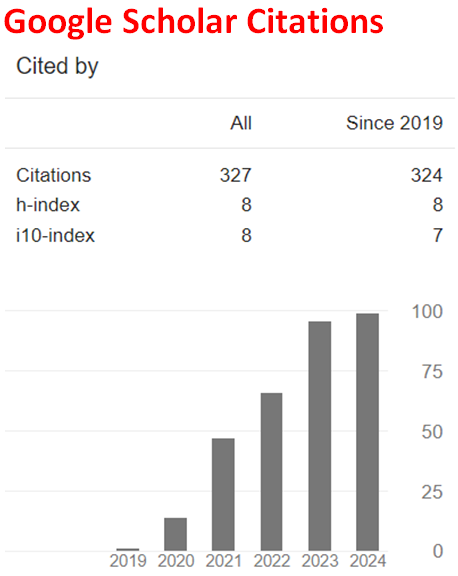Trinitroanisole isomers - A DFT treatment
Abstract
Trinitroanisole isomers have been investigated within the constraints of density functional theory at the level of B3LYP/6-311++G(d,p). All the isomers are electronically stable, thermodynamically exothermic and have favorable Gibbs’ free energy of formation values at the standard states. Various quantum chemical properties, including UV-VIS spectra have been obtained and discussed. Some of the isomers considered are associated with non-Kekule alternant isoconjugate systems, therefore they might have some potential explosive character. 2,4,6-Trinitrophenylanisole is one of them and indeed it was extensively and exclusively used by Japanese as an explosive in the II world war.
Downloads
References
Maxim, H. (1904). Explosive compound. US pat. 951445 (1904).
Maxim, H. (1905). Explosive compound. US pat. 974900 (1905).
Du Pont de Nemours, E. (1910). Process of incorporating ingredients of explosives. US pat. 976211 (1910).
Cahours, M.A. (1849). On anisole and its derivatives. The London, Edinburgh, and Dublin Philosophical Magazine and Journal of Science, 34(231), 476-478. https://doi.org/10.1080/14786444908646276
Parker, V.D., Li, Z., Handoo, K.L., Hao, W., & Cheng, J.P. (2011). The reversible consecutive mechanism for the reaction of trinitroanisole with methoxide ion. The Journal of Organic Chemistry, 76(5), 1250-1256. https://doi.org/10.1021/jo101859n
Hasegawa, Y. (1985). Kinetics of the formation of the 1,3-complex and on the formation and decomposition of the intermediate complex. Reaction of 2,4,6-trinitroanisole with n-butyl amine in dimethyl sulphoxide. J. Chem. Soc., Perkin Trans., 2, 87-92. https://doi.org/10.1039/P29850000087
Lazarov, A., Trattner, A., & Ingber, A. (2000). Military Personnel. In L. Kanerva, J.E. Wahlberg, P. Elsner & H.I. Maibach (Eds.), Handbook of occupational dermatology. Berlin, Heidelberg: Springer. https://doi.org/10.1007/978-3-662-07677-4_155
Parihar, D.B., Sharma, S.P., & Verma, K.K. (1970). Investigation of methemoglobinemic and carcinogenic poisons as π complexes with 2, 4, 6-trinitroanisole and picramide. Journal of the Forensic Science Society, 10(2), 77-82. https://doi.org/10.1016/S0015-7368(70)70569-0 .
Kovacic, P., & Somanathan, R. (2014). Nitroaromatic compounds: Environmental toxicity, carcinogenicity, mutagenicity, therapy and mechanism. Journal of Applied Toxicology, 34(8), 810-824. https://doi.org/10.1002/jat.2980
Barnes, J.C., Chudek, J.A., Foster, R., Jarrett, F., Mackie, F., Paton, J., & Twiselton, D.R. (1984). Complexes of pyrene with 2,4,6-trinitroanisole. Studies of association in solution and the crystal structure of the 1:1 complex. Tetrahedron, 40(9), 1595-1601. https://doi.org/10.1016/S0040-4020(01)91810-1
Larranaga, M.D., Lewis, R.J. Sr., & Lewis, R.A. (2016). Hawley’s condensed chemical dictionary (16th ed.). Hoboken, NJ: John Wiley & Sons, Inc., p. 1383.
Urbansky, T. (1984). Chemistry and technology of explosives. New York: MacMillan.
Japanese Explosive Ordnance. (1946). Op 1667, 14 June. V. I, Washington 25, D.C.: Navy department bureau of ordnance.
Japanese Air Bombs from Tactical and Technical Trends. (1943). U.S. War Department publication, A report on Japanese WWII bombs. Tactical and Technical Trends, No. 28, July 1.
PubChem. “2,4,6-Trinitroanisole”. pubchem.ncbi.nlm.nih.gov. Retrieved 2023-11-13.
Fedoroff, B.T., Aaronson, H.A, Sheffield, O.E., Rees, E.F., & Clift, C.D. (1966). Encyclopedia of explosives and related items (Vol. 1, pp. A450-A453). Dover, N.J.: Picatinny Arsenal.
Stewart, J.J.P. (1989). Optimization of parameters for semi-empirical methods I. J. Comput. Chem., 10, 209-220. https://doi.org/10.1002/jcc.540100208
Stewart, J.J.P. (1989). Optimization of parameters for semi-empirical methods II. J. Comput. Chem., 10, 221-264. https://doi.org/10.1002/jcc.540100209
Leach, A.R. (1997). Molecular modeling. Essex: Longman.
Kohn, W., & Sham, L.J. (1965). Self-consistent equations including exchange and correlation effects. Phys. Rev., 140, 1133-1138. https://doi.org/10.1103/PhysRev.140.A1133
Parr, R.G., & Yang, W. (1989). Density functional theory of atoms and molecules. London: Oxford University Press.
Becke, A.D. (1988). Density-functional exchange-energy approximation with correct asymptotic behavior. Phys. Rev. A, 38, 3098-3100. https://doi.org/10.1103/PhysRevA.38.3098
Vosko, S.H., Wilk, L., & Nusair, M. (1980). Accurate spin-dependent electron liquid correlation energies for local spin density calculations: a critical analysis. Can. J. Phys., 58, 1200-1211. https://doi.org/10.1139/p80-159
Lee, C., Yang, W., & Parr, R.G. (1988). Development of the Colle-Salvetti correlation energy formula into a functional of the electron density. Phys. Rev. B, 37, 785-789. https://doi.org/10.1103/PhysRevB.37.785
SPARTAN 06 (2006). Wavefunction Inc. Irvine CA, USA.
Dewar, J.M.S. (1969). The molecular orbital theory of organic chemistry. New York: McGraw-Hill.
Dewar, M.J.S., & Dougherty, R.C. (1975). The PMO theory of organic chemistry. New York: Plenum/Rosseta.
Türker, L. (2004). Possibility of cyclic transition states of nitroglycerine. Theochem, 68, 15-19. https://doi.org/10.1016/j.theochem.2004.03.037
Türker, L. (2011). Recent developments in the theory of explosive materials, In T.J. Jansen (Ed.), Explosive materials, materials science and technologies. New York: Nova Science Pub.
Türker, L.(2009). Structure-impact sensitivity relation of certain explosive compounds. J. of Energetic Mater., 27, 94-109. https://doi.org/10.1080/07370650802405182
Klapötke, T. M. (2011). Chemistry of high-energy materials. Berlin: De Gruyter. https://doi.org/10.1515/9783110227840
Anbu, V., Vijayalakshmi, K.A., Karunathan, R., Stephen, A.D., & Nidhin, P.V. (2019). Explosives properties of high energetic trinitrophenyl nitramide molecules: A DFT and AIM analysis. Arabian Journal of Chemistry, 12(5) 621-632. https://doi.org/10.1016/j.arabjc.2016.09.023
Badders, N.R., Wei, C., Aldeeb, A.A., Rogers, W.J., & Mannan, M.S. (2006). Predicting the impact sensitivities of polynitro compounds using quantum chemical descriptors, Journal of Energetic Materials, 24, 17-33. https://doi.org/10.1080/07370650500374326

This work is licensed under a Creative Commons Attribution 4.0 International License.


